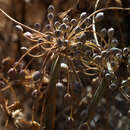en
names in breadcrumbs


Bulb is ovoid. Outer tunics membranous, greyish-black, splitting lengthways. stem straight or flexuose. leaves 2-4, 0.5-1 mm wide, nearly as long as or slightly exceeding the inflorescence. sheathing the lower 1/2 to 1/3 of the stem. Spathe 2-valved, persistent, the valves wide at the base, tapering gradually into long slender appendages, longer than the umbel. Umbel oblong to fastigiate, the pedicels at first pendent then becoming patent and finally erect. pedicels unequal. Perianth campanulate, pink or pale purple, usually with a darker reddish midvein, oblong or oblong- oblanceolate, obtuse to subacute or rounded; filaments simple, expanded at the base and subulate at the apex. Anthers fully exserted, yellow; style exserted. Capsule, depressed-subglobose, trigonous. Flowers usually smaller, yellowish-green or greyish-green. filaments and anthers much exserted.
Sinai, Palastine.
Rocky places.
Height: 10-35 cm.
Allium decaisnei is a species of onion found in Israel, Palestine, Jordan, and the Sinai Peninsula in Egypt.[2] It is a perennial with an upright scape. Umbel is loose, with long-pediceled green flowers, most of them nodding (drooping).[3][4][5]
Some authorities categorize this taxon as a subspecies of A. stamineum,[6][7] with others consider the name a synonym of A. flavum.[8]
Allium decaisnei is a species of onion found in Israel, Palestine, Jordan, and the Sinai Peninsula in Egypt. It is a perennial with an upright scape. Umbel is loose, with long-pediceled green flowers, most of them nodding (drooping).
Some authorities categorize this taxon as a subspecies of A. stamineum, with others consider the name a synonym of A. flavum.